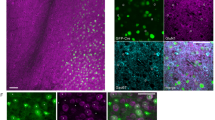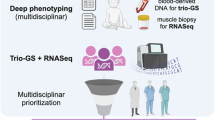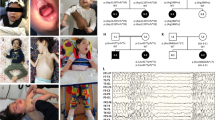Abstract
The molecular mechanisms by which different mutations in the same gene can result in distinct disease phenotypes remain largely unknown. Truncating mutations of SOX10 cause either a complex neurocristopathy designated PCWH or a more restricted phenotype known as Waardenburg-Shah syndrome (WS4; OMIM 277580). Here we report that although all nonsense and frameshift mutations that cause premature termination of translation generate truncated SOX10 proteins with potent dominant-negative activity, the more severe disease phenotype, PCWH, is realized only when the mutant mRNAs escape the nonsense-mediated decay (NMD) pathway. We observe similar results for truncating mutations of MPZ that convey distinct myelinopathies. Our experiments show that triggering NMD and escaping NMD may cause distinct neurological phenotypes.
This is a preview of subscription content, access via your institution
Access options
Subscribe to this journal
Receive 12 print issues and online access
$259.00 per year
only $21.58 per issue
Buy this article
- Purchase on SpringerLink
- Instant access to full article PDF
Prices may be subject to local taxes which are calculated during checkout





Similar content being viewed by others
References
Inoue, K., Tanabe, Y. & Lupski, J.R. Myelin deficiencies in both the central and the peripheral nervous systems associated with a SOX10 mutation. Ann. Neurol. 46, 313–318 (1999).
Inoue, K. et al. Congenital hypomyelinating neuropathy, central dysmyelination, and Waardenburg-Hirschsprung disease: phenotypes linked by SOX10 mutation. Ann. Neurol. 52, 836–842 (2002).
Kuhlbrodt, K., Herbarth, B., Sock, E., Hermans-Borgmeyer, I. & Wegner, M. Sox10, a novel transcriptional modulator in glial cells. J. Neurosci. 18, 237–250 (1998).
Herbarth, B. et al. Mutation of the Sry-related Sox10 gene in Dominant megacolon, a mouse model for human Hirschsprung disease. Proc. Natl. Acad. Sci. USA 95, 5161–5165 (1998).
Southard-Smith, E.M., Kos, L. & Pavan, W.J. Sox10 mutation disrupts neural crest development in Dom Hirschsprung mouse model. Nat. Genet. 18, 60–64 (1998).
Sonnenberg-Riethmacher, E. et al. Development and degeneration of dorsal root ganglia in the absence of the HMG-domain transcription factor Sox10. Mech. Dev. 109, 253–265 (2001).
Stolt, C.C. et al. Terminal differentiation of myelin-forming oligodendrocytes depends on the transcription factor Sox10. Genes Dev. 16, 165–170 (2002).
Britsch, S. et al. The transcription factor Sox10 is a key regulator of peripheral glial development. Genes Dev. 15, 66–78 (2001).
Pingault, V. et al. SOX10 mutations in patients with Waardenburg-Hirschsprung disease. Nat. Genet. 18, 171–173 (1998).
Southard-Smith, E.M. et al. The Sox10Dom mouse: modeling the genetic variation of Waardenburg-Shah (WS4) syndrome. Genome Res. 9, 215–225 (1999).
Pingault, V. et al. SOX10 mutations in chronic intestinal pseudo-obstruction suggest a complex physiopathological mechanism. Hum. Genet. 111, 198–206 (2002).
Omenn, G.S. & McKusick, V.A. The association of Waardenburg syndrome and Hirschsprung megacolon. Am. J. Med. Genet. 3, 217–223 (1979).
Warner, L.E. et al. Clinical phenotypes of different MPZ (P0) mutations may include Charcot-Marie-Tooth type 1B, Dejerine-Sottas, and congenital hypomyelination. Neuron 17, 451–460 (1996).
Pingault, V. et al. Peripheral neuropathy with hypomyelination, chronic intestinal pseudo-obstruction and deafness: a developmental 'neural crest syndrome' related to a SOX10 mutation. Ann. Neurol. 48, 671–676 (2000).
Jacobs, J.M. & Wilson, J. An unusual demyelinating neuropathy in a patient with Waardenburg's syndrome. Acta Neuropathol. 83, 670–674 (1992).
Touraine, R.L. et al. Neurological phenotype in Waardenburg syndrome type 4 correlates with novel SOX10 truncating mutations and expression in developing brain. Am. J. Hum. Genet. 66, 1496–1503 (2000).
Sham, M.H., Lui, V.C.H., Chen, B.L.S., Fu, M. & Tam, P.K.H. Novel mutations of SOX10 suggest a dominant negative role in Waardenburg-Shah syndrome. J. Med. Genet. 38, E30 (2001).
Bondurand, N. et al. A molecular analysis of the Yemenite deaf-blind hypopigmentation syndrome: SOX10 dysfunction causes different neurocristopathies. Hum. Mol. Genet. 8, 1785–1789 (1999).
Toki, F. et al. Intestinal agangliosis associated with the Waardenburg syndrome: report of two cases and review of the literature. Pediatr. Surg. Int. 19, 725–728 (2003).
Bondurand, N. et al. Human Connexin 32, a gap junction protein altered in the X-linked form of Charcot-Marie-Tooth disease, is directly regulated by the transcription factor SOX10. Hum. Mol. Genet. 10, 2783–2795 (2001).
Kuhlbrodt, K. et al. Functional analysis of Sox10 mutations found in human Waardenburg-Hirschsprung patients. J. Biol. Chem. 273, 23033–23038 (1998).
Carter, M.S., Li, S. & Wilkinson, M.F. A splicing-dependent regulatory mechanism that detects translation signals. EMBO J. 15, 5965–5975 (1996).
Nagy, E. & Maquat, L.E. A rule for termination-codon position within intron-containing genes: when nonsense affects RNA abundance. Trends Biochem. Sci. 23, 198–199 (1998).
Carter, M.S. et al. A regulatory mechanism that detects premature nonsense codons in T-cell receptor transcripts in vivo is reversed by protein synthesis inhibitors in vitro. J. Biol. Chem. 270, 28995–29003 (1995).
Saifi, G.M., Szigeti, K., Snipes, G.J., Garcia, C.A. & Lupski, J.R. Molecular mechanisms, diagnosis, and rational approaches to management and therapy for Charcot-Marie-Tooth disease and related peripheral neuropathies. J. Investig. Med. 51, 261–283 (2003).
Wong, M-H. & Filbin, M.T. Dominant-negative effect on adhesion by myelin Po protein truncated in its cytoplasmic domain. J. Cell Biol. 134, 1531–1541 (1996).
Mendell, J.T., ap Rhys, C.M.J. & Dietz, H.C. Separable roles for rent1/hUpf1 in altered splicing and decay of nonsense transcripts. Science 298, 419–422 (2002).
Frischmeyer, P.A. & Dietz, H.C. Nonsense-mediated mRNA decay in health and disease. Hum. Mol. Genet. 8, 1893–1900 (1999).
Mendell, J.T. & Dietz, H.C. When the message goes awry: disease-producing mutations that influence mRNA content and performance. Cell 107, 411–414 (2001).
Byers, P.H. Killing the messenger: new insights into nonsense-mediated mRNA decay. J. Clin. Invest. 109, 3–6 (2002).
Körkkö, J. et al. Analysis of the COL1A1 and COL1A2 genes by PCR amplification and scanning by conformation-sensitive gel electrophoresis identifies only COL1A1 mutations in 15 patients with osteogenesis imperfecta type I: identification of common sequences of null-allele mutations. Am. J. Hum. Genet. 62, 98–110 (1998).
Snead, M.P. & Yates, J.R.W. Clinical and Molecular genetics of Stickler syndrome. J. Med. Genet. 36, 353–359 (1999).
Dietz, H.C. et al. Four novel FBN1 mutations: significance for mutant transcript level and EGF-like domain calcium binding in the pathogenesis of Marfan syndrome. Genomics 17, 468–475 (1993).
Schrijver, I. et al. Premature termination mutations in FBN1: distinct effects on differential allelic expression and on protein and clinical phenotypes. Am. J. Hum. Genet. 71, 223–237 (2002).
Baserga, S.J. & Benz, E.J. Jr. Nonsense mutations in the human β-globin gene affect mRNA metabolism. Proc. Natl. Acad. Sci. USA 85, 2056–2060 (1988).
Forget, B.G., Benz, E.J., Jr., Skoultchi, A., Baglioni, C. & Housman, D. Absence of messenger RNA for β globin chain in β0-thalassaemia. Nature 247, 379–381 (1974).
Shames, I., Fraser, A., Colby, J., Orfali, W. & Snipes, G.J. Phenotypic differences between peripheral myelin protein-22 (PMP22) and myelin protein zero (P0) mutations associated with Charcot-Marie-Tooth-related diseases. J. Neuropathol. Exp. Neurol. 62, 751–764 (2003).
Yoshida, M. & Colman, D.R. Rapid functional analysis in Xenopus oocytes of Po protein adhesive interactions. Neurochem. Res. 26, 703–712 (2001).
Edery, P. et al. Mutation of the endothelin-3 gene in the Waardenburg-Hirschsprung disease (Shah-Waardenburg syndrome). Nat. Genet. 12, 442–444 (1996).
Puffenberger, E.G. et al. A missense mutation of the endothelin-B receptor gene in multigenic Hirschsprung's disease. Cell 79, 1257–1266 (1994).
Kerr, T.P., Sewry, C.A., Robb, S.A. & Roberts, R.G. Long mutant dystrophins and variable phenotypes: evasion of nonsense-mediated decay? Hum. Genet. 109, 402–407 (2001).
Medghalchi, S.M. et al. Rent1, a trans-effector of nonsense-mediated mRNA decay, is essential for mammalian embryonic viability. Hum. Mol. Genet. 10, 99–105 (2001).
Peirano, R.I., Goerich, D.E., Riethmacher, D. & Wegner, M. Protein zero gene expression is regulated by the glial transcription factor Sox10. Mol. Cell. Biol. 20, 3198–3209 (2000).
Wang, J., Gudikote, J.P., Olivas, O.R. & Wilkinson, M.F. Boundary-independent polar nonsense-mediated decay. EMBO Rep. 3, 274–279 (2002).
Acknowledgements
We thank the affected individuals and their families for their cooperation; M. Quanrud for collecting blood samples from family members; T. Shimotake and Y. Tsuchida for providing clinical information; R. Peirano and E. Sock for advice and assistance; and A. Beaudet, H. Bellen, K. Szigeti and H. Zoghbi for critical reviews. This study was supported in part by grants from the US National Institute for Neurological Disorders and Strokes, the US National Institutes of Health and the Muscular Dystrophy Association to J.R.L. K.I. was a fellow of the Charcot-Marie-Tooth Association when this study was initiated and is currently supported by a development grant from the Muscular Dystrophy Association.
Author information
Authors and Affiliations
Corresponding author
Ethics declarations
Competing interests
The authors declare no competing financial interests.
Supplementary information
Rights and permissions
About this article
Cite this article
Inoue, K., Khajavi, M., Ohyama, T. et al. Molecular mechanism for distinct neurological phenotypes conveyed by allelic truncating mutations. Nat Genet 36, 361–369 (2004). https://doi.org/10.1038/ng1322
Received:
Accepted:
Published:
Issue date:
DOI: https://doi.org/10.1038/ng1322
This article is cited by
-
A Novel Frameshift Variant of the ELF4 Gene in a Patient with Autoinflammatory Disease: Clinical Features, Transcriptomic Profiling and Functional Studies
Journal of Clinical Immunology (2024)
-
A novel PAX6 variant as the cause of aniridia in a Chinese patient with SRRRD
BMC Medical Genomics (2023)
-
Identification of molecular targets of Trigonelline for treating breast cancer through network pharmacology and bioinformatics-based prediction
Molecular Diversity (2023)
-
Whole exome analysis of patients in Japan with hearing loss reveals high heterogeneity among responsible and novel candidate genes
Orphanet Journal of Rare Diseases (2022)
-
Three novel variants in SOX10 gene: Waardenburg and PCWH syndromes
Egyptian Journal of Medical Human Genetics (2022)



